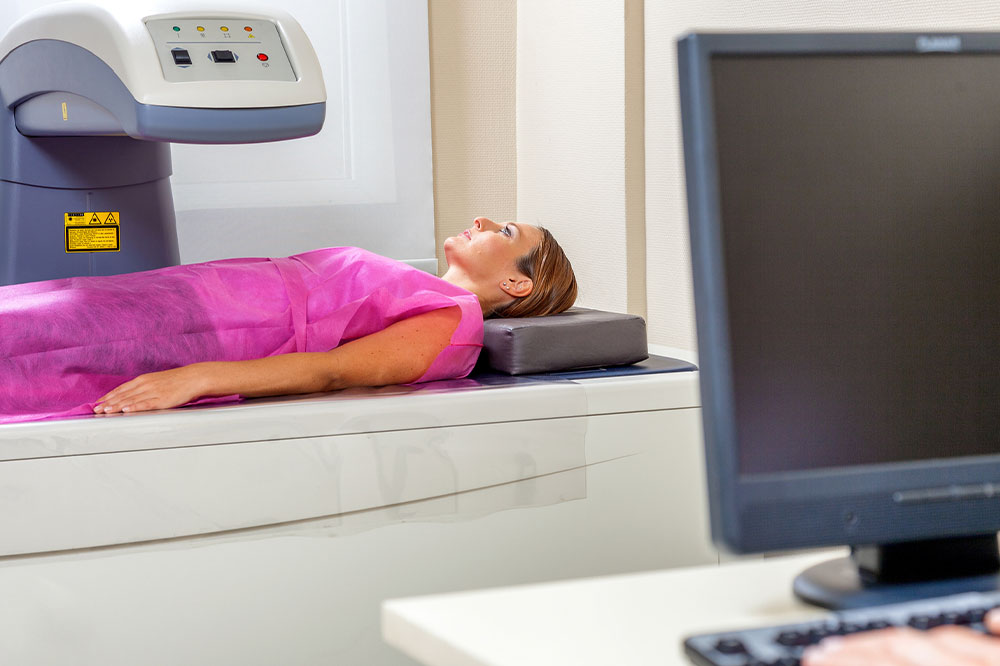
Bone density test – Purpose, procedure, and cost
Bone density tests are conducted to check for conditions like osteopenia and osteoporosis and determine the strength and thickness of the bone. It does so by checking the calcium and other mineral content in the bones. Also referred to as the DEXA scan, the bone density test is a low-dose X-ray test designed to diagnose bone conditions, predict the risk of fractures, and check if the prescribed treatments are working.
Who needs a bone density test?
As people age, their bones begin to deteriorate, which increases the risk of fractures and other physical injuries. Women over 65 and men over 70 are most susceptible to losing bone density, which puts them at a higher risk of injuries in the future. Other people who may be at a higher risk include:
Those with a low BMI
Those who have had one or more fractures since the age of 50
Those who have lost an inch or more in height over the past year
People with a family history of osteoporosis
Lack of physical activity and inadequate nutrition (especially insufficient calcium and vitamin D) can also put one at risk for osteopenia.
Procedure
The most common bone density test procedure is a dual-energy X-ray absorptiometry or the DEXA scan, which is usually conducted in the radiologist’s office. The patient is expected to lie on a padded table with their legs straight or on a raised platform. The scanning machine will then pass over the lower spine and hip, while a photon generator will pass beneath the patient. Patients may be asked to lay still or even hold their breath as the machine passes. The images captured by these machines are then put together and sent to a radiologist or a physician trained in DEXA interpretation. The healthcare provider is expected to send a copy of the written report to the patient to discuss the next course of action for treatment. When trying to examine smaller joints such as the fingers, forearm, hand, or foot, a portable scanner called peripheral DEXA or p-DEXA may be used.
Almost no preparation is required for a bone density test. Patients may be advised to avoid taking calcium supplements for at least 24 hours before the test. One should wear loose, comfortable clothing without zippers, belts, or buttons. Patients should avoid wearing jewelry and remove all metal objects from their pockets before the test. Some radiology labs may require patients to change into an examination gown.
How much does the test cost?
A bone density test typically costs between $150 and $250 for those who are not covered by health insurance. These tests are generally covered under Medicare and private health insurance for those at risk for osteoporosis as they age. It is important, however, to check one’s policy in advance, as plans may vary. Patients may have to pay $10 to $30 as coinsurance out of their own pockets for this test.
How are the test results evaluated?
Bone density test results are generally indicated by a T-score and a Z-score. Here’s what to expect:
T-score: It measures the person’s current bone density in comparison to the expected bone density of a healthy adult. Based on the standard deviation, the following scale is used:
- -1 and above: Normal
- Between -1 and -2.5: Low bone density, a potential sign of osteopenia
- -2.5 and below: Indicates osteoporosis
Z-score: It is the number of standard deviations above or below the expected bone density based on the patient’s age, sex, body mass, and ethnic and racial origin. Depending on the deviation, additional tests may be required to understand the underlying cause of the problem.
Limitations
Several factors may impact or distort results from a bone density test. These include:
- Differences in testing methods: Larger bone density testing devices such as DEXA machines are more accurate in determining bone density in comparison to p-DEXA devices.
- Spinal problems: Those with spine abnormalities such as scoliosis, arthritis, or other surgeries may not get accurate results with regular bone density tests.
- Radiation exposure: Even though the level of X-ray exposure is extremely low, pregnant women must avoid these tests.
- Lack of information: Although the DEXA tests are adept at providing information about one’s bone density, they may not reveal the underlying cause. To do so, a full health evaluation may be required following the test.
A bone density test is a quick, painless procedure, the purpose of which is to give information about one’s bone strength and body composition (body fat and muscle mass).




